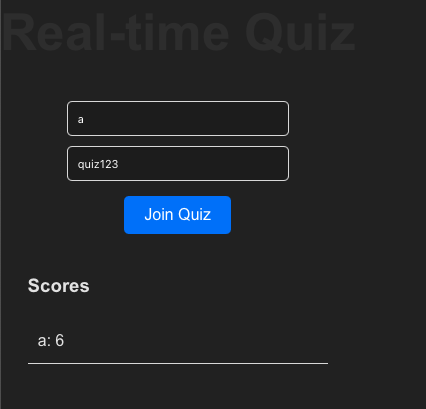This is a learning project to create a technical solution for a real-time quiz feature for an English learning application. This feature will allow users to answer questions in real-time, compete with others, and see their scores updated live on a leaderboard.
- Frontend (Client): React.js for building interactive single page app.
- Backend: Express.js with TypeScript for REST APIs and WebSocket-based with Socket.io and Redis adapter for real-time updates.
- Database: PostgreSQL for storing quiz data, Redis for caching and live leaderboard management.
- Cloud Hosting: AWS for scalable infrastructure.
- Frontend (Client):
- Connects to the WebSocket server for real-time updates on the quiz and leaderboard.
- Fetches questions and posts answers through REST APIs.
- WebSockets Server:
- Manages the real-time communication between the users and the backend.
- Updates the leaderboard live as users submit answers.
- Manages quiz state (timers, score, active participants, etc.).
- REST API:
- Handles CRUD operations for quizzes, users, and leaderboard data.
- Fetches the questions for each quiz round from the database.
- Submits the user’s answers to be processed.
- Real-Time Quiz Logic:
- Contain main business logic such as timing, score calculation, and answer validation.
- Updates Redis with the real-time leaderboard and manages active players’ data.
- Redis:
- Used for storing and retrieving the live leaderboard data, reducing the load on the database.
- Keeps track of active participants and their current scores.
- PostgreSQL:
- Stores all persistent data, including questions, answers, users, quiz results, etc.
- User Joins
- The user logs into the app and joins a quiz session.
- The WebSocket connection is established with the server.
- The WebSocket server sends the initial quiz data (e.g., number of questions, current leaderboard) to the user.
- Quiz Starts
- The quiz server sends questions to all connected users simultaneously via WebSocket.
- A timer is managed on both the server and client to sync the quiz round duration.
- User Submits Answer
- The answer is sent to the WebSocket server.
- The WebSocket server places the answer in a Redis queue for async processing.
- Answer Processing
- The backend fetches the user’s answer from the Redis queue to validate and give scores.
- The score is updated in Redis (leaderboard).
- Leaderboard Update
- The live leaderboard is continuously updated to the frontend via WebSocket from Redis.
- Users can see the updated scores and ranks in real-time.
- Quiz Ends
- Final scores are calculated and stored persistently in PostgreSQL.
- The user’s quiz history performance can also be saved for future analytics.
- Frontend:
- React with Vite: For the interactive UI, handling real-time updates with WebSockets.
- WebSocket API: For real-time communication between clients and server.
- Backend:
- Express.js with TypeScript: For handling both REST API and WebSocket communication.
- Socket.io: For low-latency, bidirectional and event-based communication between a client and a server. It adds an abstraction on websockets transport with additional features like reconnection, broadcasting, etc.
- Redis adapter: Used with Socket.io to make use of Redis pub/sub mechanism.
- Redis: To store real-time leaderboard data with high-speed access.
- PostgreSQL: For storing quiz questions, users, and scores.
- Infrastructure:
- Docker and AWS ECR: For containerizing the backend services and managing container images.
- AWS Fargate and Application Load Balancer: Cloud hosting solutions for handling dynamic scaling and load balancing.
- Amazon RDS for PostgreSQL: for auto handling backups, monitoring, and scaling.
- Amazon ElastiCache for Redis: for managing Redis clusters.
The project will use npm workspace as a monorepo for both backend and frontend apps.
├── README.md
├── apps
│ ├── backend
│ └── frontend
├── assets
│ └── system.png
And for the simplicity of a demo, I only implement a core feature which is Real-time Score Updates: Users' scores should be updated in real-time as they submit answers.
So the frontend will be a simple page built with React to allow user to input userId and quizId, click Join Quiz button and see the latest scores.
The action of submitting answer will be done through a POST endpoint /api/submit-answer to call to the backend to calculate score for user.
// sample payload
{
"quizId": "quiz123",
"userId": "a",
"questionId": "question1",
"answerId": "answer3"
}
- Run
npm installat rool to install dependencies. - Change directory to
apps/backendthen rundocker compose up --buildto start server and redis. - Change directory to
apps/frontendthen runnpm run devto start Vite app. - Open
localhost:5173on browser > inputuserIdandquizIdto join. Should usequiz123as quizId because it is hardcoded for testing with scores. - Open Postman to make a POST request to
localhost:3000/api/submit-answerwith the samplepayload above. - Verify scores updated on browser.
Note: Right-click the image and select "Open link in new tab" to view the video.



